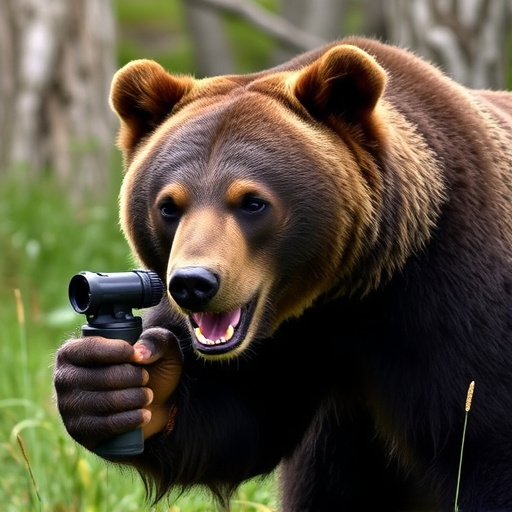Bear spray, with capsaicin as its active ingredient, creates a protective barrier against aggressive bears up to 35 feet (10 meters). The best distance pattern varies based on environment, including wind, humidity, and temperature. For most outdoor activities, a 20-35 feet (6-10 meter) range is effective; however, in open fields or remote areas, a longer reach of 40-60 feet (12-18 meters) is recommended. High-quality sprays with robust pepper formulas offer better protection at longer distances, and proper usage techniques are crucial for optimal effectiveness.
“Uncover the secrets behind bear spray’s effectiveness as a deterrent in various outdoor scenarios. This comprehensive guide explores the intricacies of bear spray range and its impact on safety. From understanding the chemical composition to deciphering distance patterns, we demystify what makes bear spray a vital tool for hikers and outdoor enthusiasts. Learn how environmental factors influence performance and discover tips to choose the best bear spray tailored to your needs, ensuring peace of mind during your adventures.”
- Understanding Bear Spray: What It Is and How It Works
- Factors Affecting Bear Spray Range and Efficacy
- Deciphering the Distance Patterns of Different Bear Sprays
- Choosing the Best Bear Spray for Your Needs and Environment
Understanding Bear Spray: What It Is and How It Works
Bear spray, also known as bear repellent, is a powerful tool for self-defense against aggressive bears in their natural habitat. It’s not just another accessory for outdoor enthusiasts; it’s a vital safety measure when venturing into areas frequented by bears. This protective spray uses capsaicin, the same ingredient that gives chili peppers their heat, to deter bears from approaching.
The effectiveness of bear spray lies in its range and application pattern. The best bear spray distance patterns typically range from 20 to 35 feet (6 to 10 meters), creating a protective barrier that can be sprayed directly at an approaching bear or onto potential hiding spots like trees. When used correctly, the spray irritates the bear’s eyes, nose, and respiratory system, causing it to flee the area. Understanding these distance patterns is crucial in knowing when and how to deploy bear spray as a successful deterrent during encounters in the wild.
Factors Affecting Bear Spray Range and Efficacy
The effectiveness and range of bear spray as a deterrent depend on several factors. One key consideration is the can’s nozzle type; different nozzles create varying mist patterns, with some designs optimized for close-range defense while others offer a wider, more diffuse spray pattern suitable for longer distances. The concentration of capsaicin (the active ingredient) in the spray also plays a role; higher concentrations provide greater irritant impact but may not travel as far as lower concentrations.
Environmental conditions significantly influence bear spray range and efficacy. Wind direction and speed can carry the spray away from its intended target or cause it to settle on the ground before reaching bears. Moisture levels in the air affect how the spray disperses, while factors like temperature and humidity impact the concentration of the capsaicin solution. Understanding these variables is essential for users to choose the best bear spray distance pattern suited to their specific environment and needs.
Deciphering the Distance Patterns of Different Bear Sprays
Understanding the distance patterns of bear spray is crucial for hikers, campers, and anyone venturing into bear country. The effectiveness of bear spray decreases significantly with range, making it essential to know how far it can reach and protect you. Studies show that the best bear spray distance pattern typically ranges from 20 to 30 feet (6 to 9 meters). Beyond this range, the spray’s concentration diminishes, reducing its impact on deterring aggressive bears.
Various factors influence these distance patterns, including the quality and type of bear spray used. High-quality sprays with a strong pepper formula tend to offer better protection over longer distances. Additionally, spraying in a sweeping motion can help ensure that the spray reaches the bear’s face and eyes, maximizing its effectiveness even at slightly farther ranges.
Choosing the Best Bear Spray for Your Needs and Environment
When selecting bear spray, understanding the best distance for deterrence is key. The effective range varies based on factors like can size, valve type, and concentration of the active ingredient. Typically, a good quality bear spray should have an effective range of 20-35 feet (6-10 meters). However, for more remote or rugged environments where bears are known to roam, opt for a can with a longer distance pattern, usually around 40-60 feet (12-18 meters).
Consider the terrain and your activity level. If you’re hiking in dense forests, a slightly shorter range might be sufficient as bears tend to be more predictable in these areas. Conversely, if you frequently find yourself in open fields or alpine regions with fewer trees, a bear spray with an extended reach can offer added protection.
When selecting bear spray, understanding its effective range is key. The best bear spray should cater to your specific environment and needs, as distance patterns vary significantly between products. By considering factors like can size, ingredients, and weather conditions, you can choose a bear spray that offers the optimal protection within its proven range. Remember, knowledge is power when it comes to staying safe in bear country.
